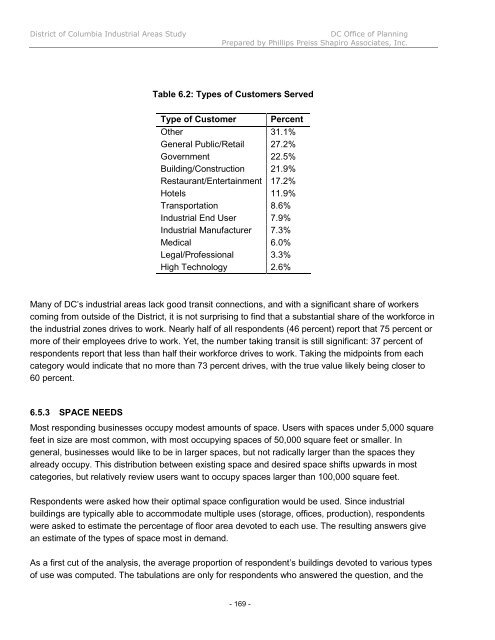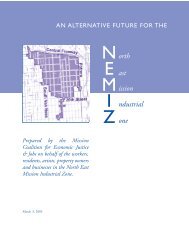INDUSTRIAL LAND IN A POST-INDUSTRIAL CITY District of ...
INDUSTRIAL LAND IN A POST-INDUSTRIAL CITY District of ...
INDUSTRIAL LAND IN A POST-INDUSTRIAL CITY District of ...
Create successful ePaper yourself
Turn your PDF publications into a flip-book with our unique Google optimized e-Paper software.
<strong>District</strong> <strong>of</strong> Columbia Industrial Areas Study DC Office <strong>of</strong> Planning<br />
Prepared by Phillips Preiss Shapiro Associates, Inc.<br />
Table 6.2: Types <strong>of</strong> Customers Served<br />
Type <strong>of</strong> Customer Percent<br />
Other 31.1%<br />
General Public/Retail 27.2%<br />
Government 22.5%<br />
Building/Construction 21.9%<br />
Restaurant/Entertainment 17.2%<br />
Hotels 11.9%<br />
Transportation 8.6%<br />
Industrial End User 7.9%<br />
Industrial Manufacturer 7.3%<br />
Medical 6.0%<br />
Legal/Pr<strong>of</strong>essional 3.3%<br />
High Technology 2.6%<br />
Many <strong>of</strong> DC’s industrial areas lack good transit connections, and with a significant share <strong>of</strong> workers<br />
coming from outside <strong>of</strong> the <strong>District</strong>, it is not surprising to find that a substantial share <strong>of</strong> the workforce in<br />
the industrial zones drives to work. Nearly half <strong>of</strong> all respondents (46 percent) report that 75 percent or<br />
more <strong>of</strong> their employees drive to work. Yet, the number taking transit is still significant: 37 percent <strong>of</strong><br />
respondents report that less than half their workforce drives to work. Taking the midpoints from each<br />
category would indicate that no more than 73 percent drives, with the true value likely being closer to<br />
60 percent.<br />
6.5.3 SPACE NEEDS<br />
Most responding businesses occupy modest amounts <strong>of</strong> space. Users with spaces under 5,000 square<br />
feet in size are most common, with most occupying spaces <strong>of</strong> 50,000 square feet or smaller. In<br />
general, businesses would like to be in larger spaces, but not radically larger than the spaces they<br />
already occupy. This distribution between existing space and desired space shifts upwards in most<br />
categories, but relatively review users want to occupy spaces larger than 100,000 square feet.<br />
Respondents were asked how their optimal space configuration would be used. Since industrial<br />
buildings are typically able to accommodate multiple uses (storage, <strong>of</strong>fices, production), respondents<br />
were asked to estimate the percentage <strong>of</strong> floor area devoted to each use. The resulting answers give<br />
an estimate <strong>of</strong> the types <strong>of</strong> space most in demand.<br />
As a first cut <strong>of</strong> the analysis, the average proportion <strong>of</strong> respondent’s buildings devoted to various types<br />
<strong>of</strong> use was computed. The tabulations are only for respondents who answered the question, and the<br />
- 169 -












